Bumble bees (Fig. 1) are prone to catch your attention by their sonicating buzz or conspicuous and colorful appearance. They are robust, fuzzy-looking insects with varying bands of coloration and a hairy abdomen- a characteristic that differentiates them from the look-alike carpenter bees. Carpenter bees have bald abdomens. Similar to honey bees, bumblebees are in the family Apidae; they are social bees but have an annual lifecycle compared to honey bees. Bumble bees are usually active from early spring through fall, visiting and collecting pollen and nectar from flowers.
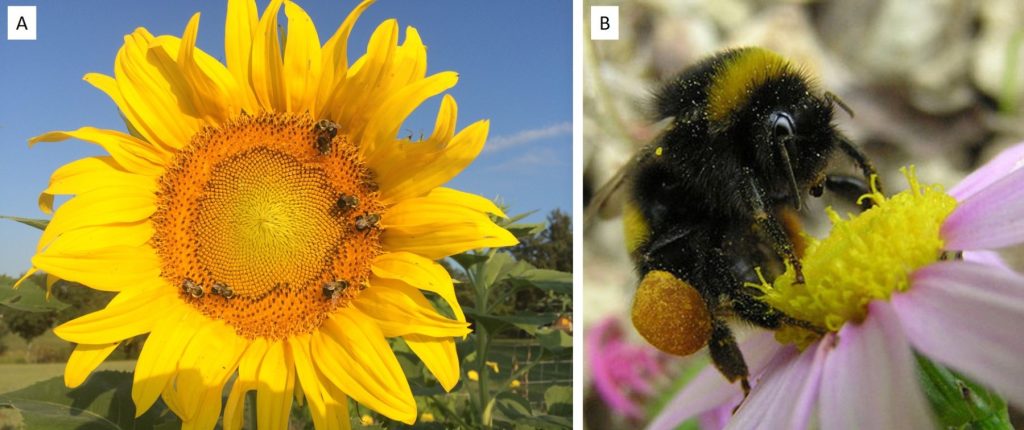
Bumble bees are distributed worldwide, with up to 260 species all over the globe. Most species are encountered in the northern hemisphere, while others are located in central and southern America and northern Africa. Forty-nine bumble bee species in the United States are known, and 17 of them are found in Georgia. Bombus impatiens (Fig. 2) is the most common bumble bee species in Georgia. The size of individual bumble bees varies across species and castes. Broadly, there are three castes, queen, workers, and drones. The queen bumble bee can vary from 17-25 mm in length; the male drones range from 13-23 mm, whereas the female workers are considerably smaller than the queen and range from 10 to 20 mm.
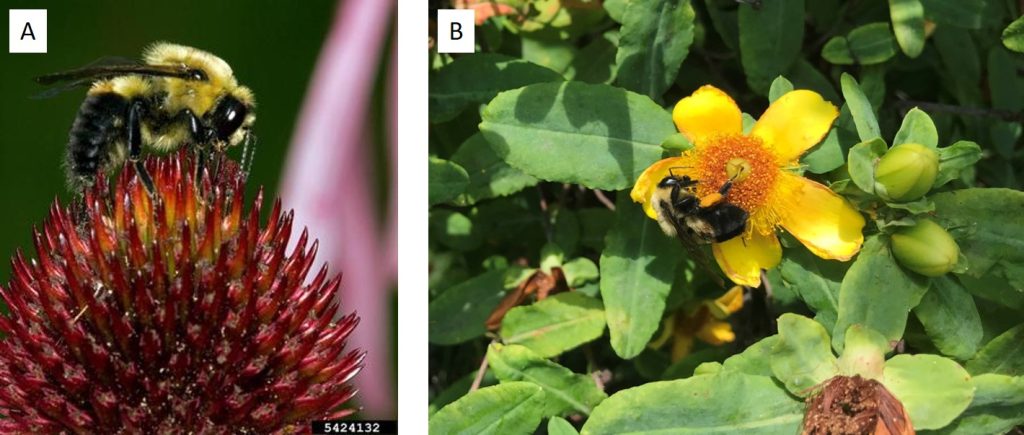
Bumble bees are greatly valued as pollinators of native and nonnative plants, including ornamentals, and cultivated plants, such as blueberries. Due to their body morphology and behavior, bumble bees are particularly efficient in pollinating certain economically important crops, such as tomatoes, cranberry, cucumber, and watermelon. Certain bumble bee species are commercially sold to greenhouses for their pollination service and are valued at up to $10 billion USD annually. Additionally, the decline in bumble bee populations has been widely reported worldwide, where agricultural intensification, habitat loss, increased use of pesticides, and microsporidian pathogen Nosema bombi are implicated in bumble bee decline. Many species of bees that were once found in certain areas are reportedly missing and haven’t been encountered in the past 10 to 15 years. For example, Bombus pensylvanicus and Bombus affinis (Fig. 3) are native bumble bees to Georgia now considered threatened or at risk of population decline.
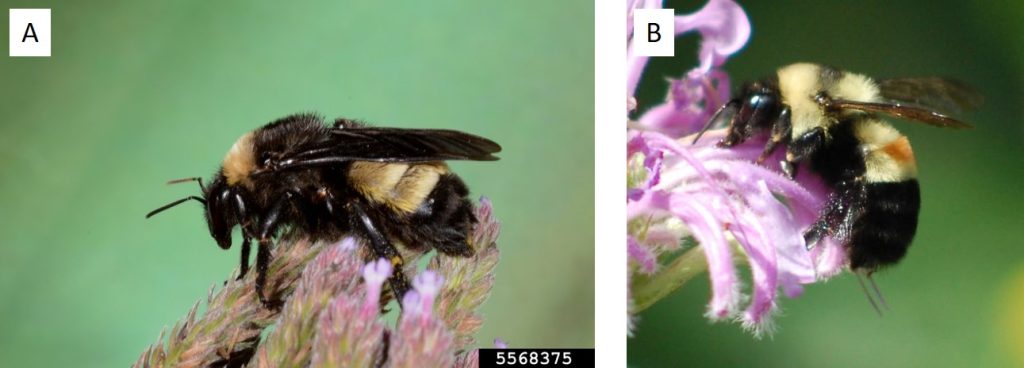
Description
Bumble bees are generally large bees with black and yellow hairs all over their bodies. They can be distinguished from other bee species by the pollen basket (corbicula) on the female’s hind legs, which is usually flattened, concave, and with hairs only around the outer edges. Honeybees also have pollen baskets.
Biology
Bumble bees are social insects with individuals responsible for performing specific functions for colony survival. The workers and males (drones) in the bumble bee colony die at the end of the summer, except the newly mated and overwintered queen (Fig. 4). The overwintered queen seeks out a new nesting site and begins a new colony in spring.

Each bumble bee colony maintains a relatively constant nest temperature regardless of the ambient temperature. They generate heat in their body by shaking their flight muscles, enabling them to be active in the wet and cool mornings of the spring. Bumble bees do not build their own nest but utilize abandoned rodent burrows, hollow logs, and open grass tussocks as nesting sites. Once a suitable nest is determined (Fig. 5), the overwintering queen gathers pollen and builds a wax honeypot (Fig. 6) for nectar storage. She lays a cluster of eggs (8-14 eggs per cluster) on a pollen ball and covers the eggs with a waxy pot called the brood clump.
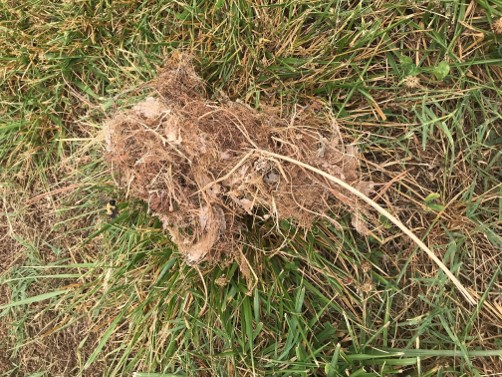
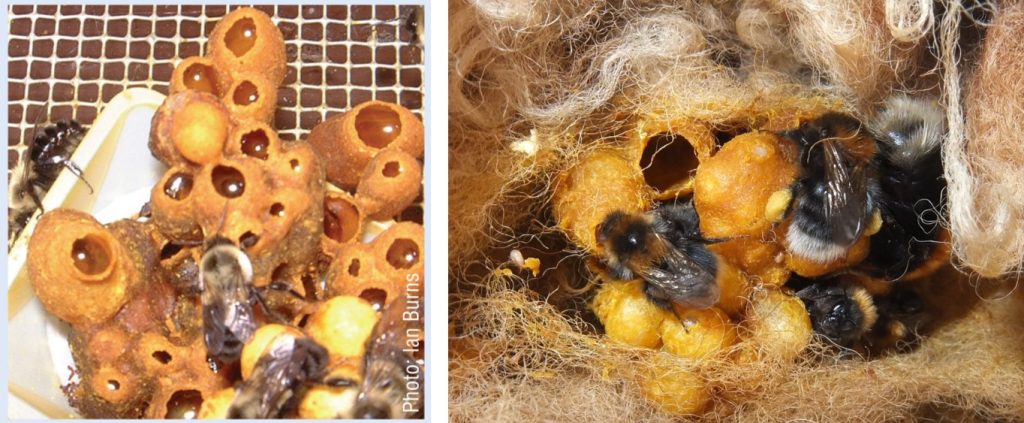
Two weeks after eggs are laid, the larvae hatch and feed on the pollen ball (Fig. 7). The queen shuffles between incubating the larvae and collecting pollen during this stage. The larvae feed for about two weeks and then form a cocoon, where they spend the pupal stage (for another two weeks) to emerge as bumble bee workers. These newly emerged female worker bees will take on foraging for resources, tending eggs and larvae, regulating the nest temperature, and defending the nest. The queen remains in the nest and continues to oviposit, increasing the colony’s size. Toward the end of the summer, the queen begins to produce males and reproductive females (queens) that will begin new colonies the following year. The new queen may mate once with only one male and feed to build fat reserves that will sustain her through overwintering. Some bumble bee queens, however, will mate with several males and mix the sperm in a storage organ called the spermatheca. By late fall, the colony dies, as they cannot withstand the adverse weather conditions except for the new queens, which burrow into the ground and remain inactive until the following spring.
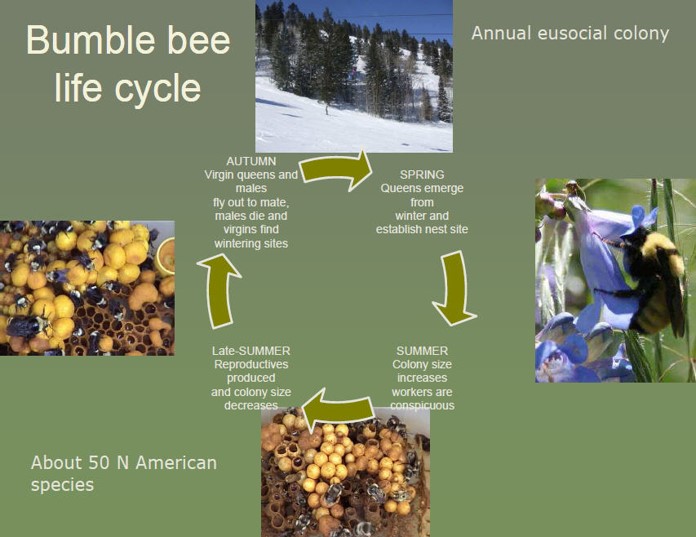
Ecology and Conservation
Bumble bees are important pollinators of many plants in landscapes and specialty crops. They forage and pollinate many wildflowers and native plants, maintaining diversity in native plant communities as they coevolve with certain native plants. They are floral generalists capable of utilizing many flower species, although they mostly focus on one plant genus in a foraging flight. Bumble bees collect pollen from certain plants by vigorously vibrating their flight muscles to release pollen from the anthers, also called buzz pollination. Economically important crops that benefit from buzz pollinations are tomatoes (Solanum lycopersicum), eggplants (Solanum melongena), cucumbers (Cucumis sativus), potatoes (Solanum tuberosum), cranberry (Vaccinium spp.), blueberries (Vaccinium spp.), squash (Cucurbita spp.), alfalfa (Medicago sativa), and clover (Trifolium spp.).
The economic value of bumble bees as efficient pollinators has increased over the years as many greenhouse production operations purchase them for their services. However, commercially produced bumble bees have been implicated in spreading pathogens, causing serious diseases to native bumble bee populations. Bumble bees interact with several plants by obtaining their nutrition from pollen and nectar. New queens visit pollen and nectar-rich flowers in early spring to build their energy stores before building the colony. The pollen is the protein much needed for the growth of young larvae in bee pots. To sustain bumble bee colonies, readily available nutritional resources are a must. Bumble bee populations face challenges, such as increased pesticide use, habitat loss or fragmentation, climate change, diseases, and natural enemies. To reduce habitat fragmentation, land should be carefully managed to minimize effects on bumble bee colonies. Developing more nesting habitats, such as planting tall grass strips and providing wildflower landscapes to promote colony survival and success, should also be considered.
References
Carril, O.M., and Wilson, J.S. (2021). Bombus, pp 201-203. In Common bees of eastern North America, Princeton University Press, New Jersey & Oxfordshire.
Gamillo, El. (2021)Bumble bee declines. https://wisconsinbumblebees.entomology.wisc.edu/about-bumble-bees/bumble-bee-declines/ Smithsonian Magazine.
Mitchell TB. 1962. Bees of the Eastern United States. Volume II. Technical Bulletin No. 152, North Carolina Agricultural Experiment Station, pp. 1-557.
Morse DH. (1982). Behavior and ecology of bumble bees, pp. 245-322 . In Hermann, H.R. (Ed.) Social Insects, Vol. 3. Academic Press, New York & London.
Stange, L.A (1998). Bees of Florida. University of Florida IFAS Extension. Retrieved from https://entnemdept.ufl.edu/creatures/misc/bees/bumble_bees
Williams, P, Thorp, R, Richardson L. and Colla, S. (2014) Identification Guide, pp 7-37. In Bumblebees of North America, Princeton University Press, New Jersey & Oxfordshire.
Cameron, SA, Lozie,r JD, Strange, JP, Jonathan BK, Cordes Nils, Solter LF and Terry L. (Griswold.2011) Patterns of widespread decline in North American bumble bees. 108: 662-667. https://doi.org/10.1073/pnas.1014743108